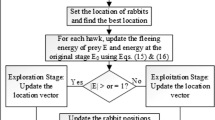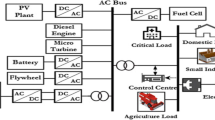Abstract
This research work proposes a modified multiverse optimizer (MMVO) technique to optimize the parameters of a 2 degree of freedom fuzzy PID (2DOF-FPID) controller for frequency control of microgrid systems. In this study, the model design consists of renewable energy sources like wind power and solar power as well as storage elements like battery energy storage systems and flywheel energy storage system with Hydrogen aqua electrolyzer integrated fuel cell unit. Initially, the performances of the MMVO technique is established over the multiverse optimizer algorithm as well as other techniques like grew wolf optimizer, gravitational search algorithm, genetic algorithm and particle swarm optimization algorithms in benchmark test functions. In the next stage, a 2 degree of freedom fuzzy PID controller (2DOF-FPID) is proposed with MMVO is applied to optimize the controller parameters. For this study, two test models are considered for minimizing the frequency fluctuations occurring due to the presence of wind and PV sources and 2DOF-FPID controllers are designed by the MMVO technique. To justify the efficacy of the planned controller, the execution of the 2DOF-FPID controller is associated with PI, PID and 2DOF-PID. A sensitivity analysis is performed by changing the system parameters to justify the robustness of the proposed controller.













Similar content being viewed by others
Explore related subjects
Discover the latest articles, news and stories from top researchers in related subjects.References
Bajpai P, Dash V (2012) Hybrid renewable energy systems for power generation in stand-alone applications: a review. Renew Sustain Energy Rev 16(5):2926–2939
Khorsandi A, Ashourloo M, Mokhtari H, Iravani R (2016) Automatic droop control for a low voltage DC microgrid. IET Gener Transm Distrib 10(1):41–47
Karami M, Seifi H, Mohammadian M (2016) Seamless control scheme for distributed energy resources in microgrids. IET Gener Transm Distrib 1:10–18
Khadanga RK, Padhy S, Panda S, Kumar A (2018) Design and analysis of multi-stage PID controller for frequency control in an islanded microgrid using a novel hybrid whale optimization-pattern search algorithm. Int J Numer Model Electron Netw Devices Fields 31(5):2349
Milani AE, Mozafari B (2011) Genetic algorithm-based optimal load frequency control in two area interconnected power system. Glob J Technol Optim 2:6–10
Khadanga RK, Satapathy JK (2015) Time delay approach for PSS and SSSC based coordinated controller design using hybrid PSO– GSA algorithm. Int J Electr Power Energy Syst 71:262–273
Ali ES, Abd-Elazim SM (2013) BFOA based design of PID controller for two area load frequency control with nonlinearities. Int J Electr Power Energy Syst 51:224–231
Mahdad B, Srairi K (2015) Interactive gravitational search algorithm and pattern search algorithms for practical dynamic economic dispatch. Int Trans Electr Energy Syst 25:2289–2309
Khadanga RK, Padhy S, Panda S, Kumar A (2018) Design and analysis of tilt integral derivative controller for frequency control in an islanded microgrid: A novel hybrid dragonfly and pattern search algorithm approach. Arab J Sci Eng 43(6):3103–3114
Sahu PC, Mishra S, Prusty RC, Panda S (2018) Improved-salp swarm optimized type-II fuzzy controller in load frequency control of multi area islanded AC microgrid. Sustain Energy Grids Netw 16:380–392
Faris H, Hassonah MA, Ala’M AZ, Mirjalili S, Aljarah I (2018) A multi-verse optimizer approach for feature selection and optimizing SVM parameters based on a robust system architecture. Neural Comput Appl 30(8):2355–2369
Mishra S, Patel S, Prusty RC, Panda S (2020) MVO optimized hybrid FOFPID-LQG controller for load frequency control of an AC micro-grid system. World J Eng 17(5):675–686
Chorasiya G, Suhag S (2020) SSA optimized 2DOF-PID controller for mitigation of frequency and tie-line power deviations in a two-area power system with integration of EV. In: 2020 4th international conference on intelligent computing and control systems (ICICCS), Madurai, India. pp. 351–356
Mishra S, Prusty RC, Panda S (2020) Design and analysis of 2dof-PID controller for frequency regulation of multi-microgrid using hybrid dragonfly and pattern search algorithm. J Control Autom Electr Syst 9:1–5
Oliva D, El Aziz MA, Hassanien AE (2017) Parameter estimation of photovoltaic cells using an improved chaotic whale optimization algorithm. Appl Energy 200:141–154
Abdel-Basset M, El-Shahat D, Sangaiah AK (2019) A modified nature inspired meta-heuristic whale optimization algorithm for solving 0–1 knapsack problem. Int J Mach Learn Cybern 10(3):495–514
Arya Y (2019) Impact of hydrogen aqua electrolyzer-fuel cell units on automatic generation control of power systems with a new optimal fuzzy TIDF-II controller. Renew Energy 139:468–482
Francis R, Chidambaram IA (2015) Optimized PI+ load-frequency controller using BWNN approach for an interconnected reheat power system with RFB and hydrogen electrolyser units. Int J Electr Power Energy Syst 67:381–392
Nayak PC, Mishra S, Prusty RC, Panda S (2020) Performance analysis of hydrogen aqua equalizer fuel-cell on AGC of Wind-hydro-thermal power systems with sunflower algorithm optimized fuzzy-PDFPI controller. Int J Ambient Energy 43:1–14
Nayak PC, Prusty RC, Panda S (2019) Grasshopper optimization algorithm of multistage PDF+(1+ PI) controller for AGC with GDB & GRC nonlinearity of dispersed type power system. Int J Ambient Energy 43:1–13
Nayak PC, Patel S, Prusty RC, Panda S (2019) MVO-PS optimized hybrid FOFPID controller for load frequency control of an AC micro-grid system. Int J Recent Technol Eng 8(2):3805–3812
Padhan S, Sahu RK, Panda S (2014) Application of firefly algorithm for load frequency control of multi-area interconnected power system. Electr Power Compon Syst 42(13):1419–1430
Arya Y, Kumar N (2017) Design and analysis of BFOA-optimized fuzzy PI/PID controller for AGC of multi-area traditional/restructured electrical power systems. Soft Comput 21(21):6435–6452
Mirjalili S, Mirjalili SM, Hatamlou A (2016) Multi-verse optimizer: a nature-inspired algorithm for global optimization. Neural Comput Appl 27(2):495–513
Funding
The research work is not supported by any funding Agency.
Author information
Authors and Affiliations
Corresponding author
Ethics declarations
Conflicts of interest
The author declares that they have no competing interests.
Additional information
Publisher's Note
Springer Nature remains neutral with regard to jurisdictional claims in published maps and institutional affiliations.
Appendix
Appendix
R1, R2 = Speed regulation constant = 0.05, 0.04 (p.u); B1, B2 = Frequency bias constants = 10,12.5 (p.u.), Tg1, Tg2 = Speed governor time constants = 0.1 (s); 0.1 (s); Tw1, Tw2 = Time constants of WT = 0.5(s), 0.5(s); Tpv1, Tpv2 = Time constants of PV = 1.5 (s), 1.5 (s); TBESS1, TBESS2 = Time constants of BESS = 0.1 (s), 0.1 (s); KT1, KT2 = Turbine gain constants = 1 (p.u.), 1 (p.u.); Kg1, Kg2 = Governor gain constants = 1 (p.u.), 1 (p.u.); KBESS1, KBESS2 = Gain constants of BESS = − 3 (p.u.), − 4 (p.u.); KFESS1, KFESS2 = Gain constant of FESS = − 1.5 (p.u.), − 2 (p.u.); KWT1, KWT2 = Gain constant of WT = 1 (p.u.), 1 (p.u.); KPV1, KPV2 = Gain constants of PV = 1 (p.u.), 1 (p.u.); M1, M2 = Inertia constants = 8 (p.u.), 8 (p.u.); D1, D2 = Damping constants = 1 (p.u.), 1 (p.u.); T12 = Synchronizing coefficient = 1.4.
Rights and permissions
About this article
Cite this article
Mishra, S., Nayak, P.C., Prusty, R.C. et al. Modified multiverse optimizer technique-based two degree of freedom fuzzy PID controller for frequency control of microgrid systems with hydrogen aqua electrolyzer fuel cell unit. Neural Comput & Applic 34, 18805–18821 (2022). https://doi.org/10.1007/s00521-022-07453-5
Received:
Accepted:
Published:
Issue Date:
DOI: https://doi.org/10.1007/s00521-022-07453-5




